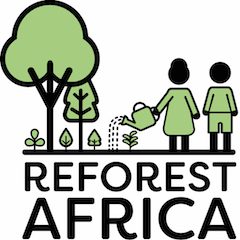Projects
See below for more information on our current Reforest Africa projects.
Forest restoration planning for the Udzungwa-Kilombero biodiversity hotspot
The work will continue establishment of our Udzungwa Botanic Garden, where we are establishing a native tree nursery containing at least 80,000 seedlings of 10 threatened tree species and 40 other native and endemic species. This will be supported by a new laboratory and seed storage facility, and training spaces for practitioners and the local community. The project will also restore 120 ha of degraded forest, including facilitating growth of 120,000 tree seedlings, through a combination of tree planting and assisted natural regeneration through liana and grass suppression, and fire management. The project also aims to engage at least 7,000 people, with equal representation of women and men from four local communities and other strategic stakeholders, to build support for forest conservation and restoration through increased awareness and engagement. This project represents Phase 2 of our Forest Landscape Restoration plan, under funding from Fondation Franklinia. The overall aim is to develop a strategic plan for the restoration of this 53,000km2 region that has huge international value for biodiversity and carbon sequestration, and national value for water catchment and agricultural production. The work will build capacity for forest restoration, while also uniting those individuals and organisations working to restore forests in the region towards a common goal.
This project represents Phase 2 of our Forest Landscape Restoration plan, under funding from Fondation Franklinia. The overall aim is to develop a strategic plan for the restoration of this 53,000km2 region that has huge international value for biodiversity and carbon sequestration, and national value for water catchment and agricultural production. The work will build capacity for forest restoration, while also uniting those individuals and organisations working to restore forests in the region towards a common goal.
Udzungwa Botanic Garden
As part of our Udzungwa-Kilombero biodiversity hotspot restoration plan, we are establishing the Udzungwa Botanic Gard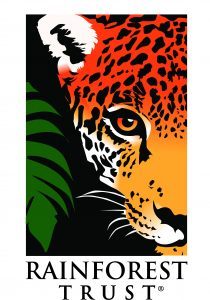 en.The garden is located on 13 acres of land immediately adjacent to the Udzungwa Mountains National Park.
en.The garden is located on 13 acres of land immediately adjacent to the Udzungwa Mountains National Park.

Within the garden we are planting and caring for hundreds of native tree species, including several rare and threatened species, as a seed source for restoring deforested areas. We are also planting trees and trialling new forms of agroforestry, so that local communities can learn new ways to generate income through planting trees together with high value crops. The garden will also form a regional training hub for forest restoration, where local people and organisations can seek information on germinating, planting and otherwise caring for plants used in forest restoration schemes. It will also provide a peaceful location for charitable ecotourism, where tourists can learn about plants and watch local wildlife [birds, monkeys, butterflies] between the excitement of the other safari adventures that the region has to offer.
Magombera Nature Reserve
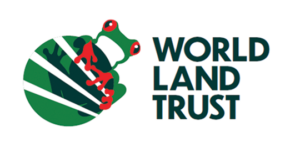


On 11th January 2019, the Government announced the establishment of the 26 km2 Magombera Nature Forest Reserve in Kilombero District, Tanzania.
The announcement was the culmination of many years of advocating for the protection of this unique forest, which we are now co-managing for the benefit of nature and people.
Magombera Nature Forest Reserve is home to a population of the Endangered Udzungwa red colobus monkey. Numerous other internationally threatened species of plants and animals are present in the new reserve, including the Magombera chameleon and the Udzungwa dwarf galago.
Magombera Forest is also important for local communities who depend on the adjacent land for rice and sugar farming. The reserve is also known as “Magombera Monkey Forest” and is becoming a popular place to visit among tourists, especially bird enthusiasts seeking a rare chance to see the elusive Pel’s fishing owl, Africa’s largest owl. It has a well-maintained tourist trail, where visitors can get wonderful views of monkeys, birds, and the nearby Udzungwa Mountains. Visitors will also certainly see signs of elephants, which roam widely across the forest at dawn and dusk, when it becomes less safe to walk around. And for each visitor entering the reserve, part of the entrance fee goes direct to local village communities. The protection of the forest has been made possible following major donations by the World Land Trust, Rainforest Trust, the Aage V. Jensen Charity Foundation and Flamingo Land. Since 2019, additional funds provided by the Rainforest Trust have paved the way for a system of joint management involving the Tanzania Forest Services Agency (TFS) and local communities. A tourism plan is also under development. The project has been implemented through a partnership involving the Tanzania Forest Conservation Group (TFCG), Reforest Africa and TFS. Magombera Monkey Forest: http://magombera.com/ Tanzania Forest Conservation Group: http://www.tfcg.org/
Udzungwa Forest Project
The aim of UFP is to better conserve tropical forests, through ten key objectives: 1) Providing education in local villages (and also the UK); 2) Providing training and capacity-building; 3) Management of habitats for biodiversity; 4) Improving income generation in villages; 5) Mitigating human-wildlife conflict; 6) Improving protection of forests; 7) Ecological and socio-economic monitoring; 8) Biodiversity conservation research/exploration; 9) Lobbying for conservation action; 10) Annual re-evaluation and revision of methods. The main emphasis of UFP is on the monitoring and management of indicators of forest conservation and the sustainability of human natural resource use. Education and capacity building in local villages is central to this, as many of the local people were previously unaware of the value of forests for water and biodiversity prior to commencement of the project. Practical activities of the project include assistance for villages in natural resource acquisition. The biggest current threats to the forest are cutting of small trees for poles and the gathering of firewood, hence most emphasis is placed on tree-planting and finding alternative sources of fuel. The forest is also routinely monitored for threats, wildlife populations and tree biodiversity/structure. Outreach to the general public in both Tanzania and the UK has included classroom teaching, film, newspaper articles, internet and a pedal-powered cinema. A large number of peer-reviewed scientific publications have been produced. Our mostly-Tanzanian team ensures that the project has a strong local connection. This allows us to integrate fully with the communities and managers. Ultimately the goal is to develop sufficient in-country income generation and capacity among villages and management authorities, such that forest conservation can continue without external support. UFP’s award-winning work has led to several achievements: 1) Over 4,000 Tanzanian children have been reached by education activities. 2) An estimated 10,000 villagers are now aware of fuel-efficient methods, with approximately 60% of households using these regularly. Tree nurseries established in four villages. 3) Experimentation with forest restoration methods has seen biodiversity and biomass increase in regenerating trees. 4) More than 9,000 tree seedlings have been donated to villagers for agroforestry. 5) Rangers from nearby reserves and villages assist with forest patrols and human-elephant conflict. 6) Ecological indicators show that forest remains intact. Trees and monkeys have shown slow declines but not below targets. A new species of tree was discovered in June 2011. 7) More than thirty peer-reviewed journal publications, seven book chapters and two books have been published since 2007 and several postgraduate projects have been facilitated. 8) Villager/conservationist feedback has been extremely positive. Memoranda of Understanding have been drafted with four villages. UFP is an international collaboration operating under the Tanzania Forest Conservation Group and Reforest Africa. The project is led by Flamingo Land Ltd. (UK), with scientific direction from Dr. Andy Marshall’s Forest Restoration and Climate Experiment (FoRCE) and Centre for Integrated Research, Conservation and Learning (CIRCLE; www.circle-conservation.org) through the University of York (UK). The project runs in partnership with local villages and the Tanzania Forestry Service. Other major collaborators include the United Bank of Carbon, Kilombero District Forest Office, IUCN Sustain, Kilombero Sugar Company, African Wildlife Foundation and Tanzania Wildlife Research Institute. We also receive external advice and assistance from academics at the University of Leeds (UK), University of Copenhagen (Denmark), Pennsylvania State University (USA), and Cambridge University (UK). The Udzungwa Forest Project is a conservation project based in southern Tanzania. While an international collaboration, the project is led by Flamingo Land Ltd. in the UK. The aim of the project is to better protect tropical forests through ecological monitoring, community education, capacity building and lobbying. UFP is based mostly in the Magombera forest, on to the east side of the breath-taking Udzungwa Mountains in Tanzania.
The Udzungwa Forest Project is a conservation project based in southern Tanzania. While an international collaboration, the project is led by Flamingo Land Ltd. in the UK. The aim of the project is to better protect tropical forests through ecological monitoring, community education, capacity building and lobbying. UFP is based mostly in the Magombera forest, on to the east side of the breath-taking Udzungwa Mountains in Tanzania. Main focus
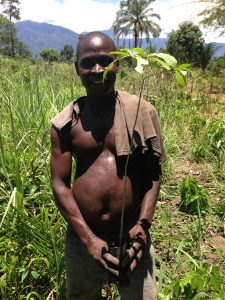
Main Achievements
Partners
Forest Landscape Restoration Planning in Tanzania

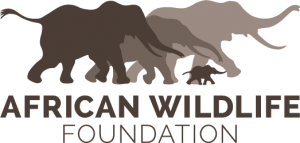

With support from the African Wildlife Foundation and the International Union for Conservation of Nature, Reforest Africa is in phase 1 of a project that trials and implements both active and passive restoration methods for the Udzungwa-Kilombero ecosystem. This will begin in lowland areas with a focus on the threatened high biodiversity forest of Magombera Conservation Area. A key output will be the development of a restoration plan for the Udzungwa-Kilombero ecosystem. Aim: To restore forest biomass and biodiversity in Udzungwa-Kilombero ecosystem Goal 1 – Restoration Capacity – To build capacity for moist forest restoration in Tanzania, with the following objectives: – Establish “Reforest Africa” (RA) as a non-governmental organisation (not-for-profit company) in Tanzania. – Recruit and train project staff and a research student. – Review previous and current restoration schemes in Tanzania and the broader tropics. – Develop methods for trialling and monitoring different forest restoration techniques. Goal 2 – Passive Restoration – To develop methods for “passive” restoration of moist forest, with the following objectives: – Establish sample plots for restoration trials in the vicinity of Magombera Conservation Area. – Clear lianas, grass and cut firebreaks and monitor changes in tree growth and recruitment compared to unmanaged control plots. Goal 3 – Active Restoration – To develop methods for “active” restoration of moist forest, with the following objectives: – Collate species information from the Udzungwa-Kilombero ecosystem to develop a provisional list of target tree and liana species for seed collection and planting. – Collect seeds and develop germination methods. – Grow seeds in nurseries for planting in the Magombera Conservation Area and adjacent villages. – Develop a provisional framework species list for the region for future reforestation schemes. – Develop a long-term protocol for lowland seed collection/storage/sale. Goal 4 – Restoration Planning – To use findings from goals 1-3 to plan future forest restoration, with the following objectives: – Planning workshop involving all key partners and collaborators. – Communicate experimental findings to all key partners and collaborators. – Develop a plan for subsequent work in phases 2 and 3. Phase 2 goals will then develop the work to continue monitoring progress such that the methods can be finalised for Magombera and other lowland regions, hence finalising recommendations and training for practitioners. Phases 2 and 3 will also expand the work to higher elevations in the region. The work will focus on the 26km2 Magombera Conservation Area and adjacent village and agricultural land. For the past 12 years Dr Andrew Marshall has been researching the ecology of this area because of its high value for biodiversity and continued habitat degradation from illegal activity (Marshall 2008). The area has no protected status, but Dr Marshall’s Udzungwa Forest Project (UFP) team has been carrying out interim conservation management through Memoranda of Understanding with nearby villages. Meanwhile the Tanzanian Government, partial landowner KSC and UFP (through TFCG) are reaching terms on the development of a new Magombera Nature Reserve to protect the area. Magombera is home to the IUCN Vulnerable Udzungwa red colobus monkey Procolobus gordonorum and the restricted range Udzungwa dwarf galago Galagoides zanzibaricus udzungwensis. Accordingly, it is among the top ten Priority Primate Areas in Tanzania, but the only one of these without protected status (Davenport et al. 2013). Recently the high profile discovery of the Magombera chameleon Kinyongia magomberae further added to the biodiversity value (Menegon et al. 2009). The forest also borders the Selous Game Reserve Important Bird Area and is home to the uncommon Pel’s fishing owl Scotopelia peli. It is also an occasional seasonal refuge for elephants, buffalo and hippopotamus of the adjacent Selous Game Reserve. Magombera also has a tree community of exceptional conservation value with an entirely unique species composition, including Polyalthia verdcourtii, known only from two locations. The area is home to species typical of both the Udzungwa Mountains and Kilombero Valley. Hence to ensure a sufficient species pool for restoring degraded areas of Magombera Conservation Area and to help plans for a broader restoration strategy, our phase 1 focus also extends to the greater Udzungwa-Kilombero ecosystem (Annex 1), beginning with areas below 800m elevation. Phases 2-3 will address higher elevations up to 2,000m.GOALS/OBJECTIVES
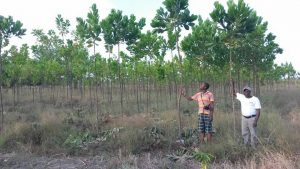
LOCATION/PROJECT AREA
